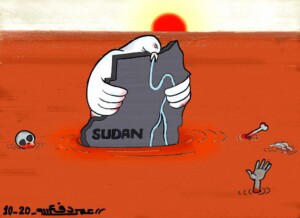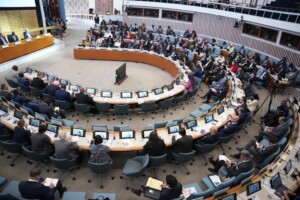1,400 newly displaced from Jebel Marra to South Darfur in one week: OCHA
An estimated 1,400 newly displaced people from the Jebel Marra area have been reported in South Darfur during the past week. This brings the total reported number of Jebel Marra IDPs in South Darfur to 10,991, of which 2,366 people have been initially registered by IOM (in Kass town and Otash camp).
An estimated 1,400 newly displaced people from the Jebel Marra area have been reported in South Darfur during the past week. This brings the total reported number of Jebel Marra IDPs in South Darfur to 10,991, of which 2,366 people have been initially registered by IOM (in Kass town and Otash camp).
According to the latest humanitarian bulletin by the United Nations Office for the Coordination of Humanitarian Affairs (OCHA), on 25 April, an interagency rapid needs assessment mission visited Malam town in Al Wehda locality, about 130km north of Nyala, South Darfur’s capital. The objective of the mission was to assess the humanitarian situation and needs of people who had arrived in El Malam from the Eastern Jebel Mara. Community leaders informed the mission that there are a total of 1,400 new IDPs in Malam who arrived from the villages of Arasho, Belli Sereif, Tirba, Sawani and Laiba in East Jebel Marra during March-April 2016 following hostilities between government forces and the Sudan Liberation Army – Abdul Wahid (SLA-AW) that started in mid-January. There are also about 3,500 old caseload IDPs in El Malam who have been living there since 2003, according to community leaders.
While both the new and protracted IDPs have access to health services at Malam rural hospital, the facility does not have sufficient medical personnel and medicine. The Expanded Programme on Immunization (EPI) is in place and all children under the age of five in the area were vaccinated during the recent immunisation campaign of 18- 20 April. The national NGO National Initiative for Development Organization (NIDO) is planning to start nutrition activities in El Malam and a site has been allocated for these activities. In terms of access to water and sanitation services, there are 36 water points, half of them are functioning and the other half are not. A set of recommendations based on the findings have been identified for follow-up.
Jebel Marra IDPs in Central Darfur
The current cumulative number of IDPs reported by HAC in Central Darfur stands at 13,020 and includes those areas where international humanitarian partners either have no access or only have partial access (Guldo, Nertiti, Thur and Golo). Anecdotal information from other sources indicates that between 44,000 and 89,000 people could be displaced in other areas, including Boori and Wadi Boori. There have been reports of hostilities in the Boori area over the past week, with no reports available on the impact of these hostilities on IDPs in the area. Meanwhile, the total registered/verified number of Jebel Marra IDPs in Central Darfur is 1,629 people and only comprises Hasahisa and Hameedia camps in Zalingei town where basic humanitarian assistance for the new arrivals is ongoing with no major gaps. Additionally, community leaders in Zalingei IDP camps reported more than 600 arrivals from Jebel Marra to both Hasahisa and Hameedia IDP camps in Zalingei town over the past week. An inter-agency assessment mission is scheduled for 3 May to verify this caseload and determine their humanitarian needs. Humanitarian agencies have been calling for unfettered and sustained access to areas affected by conflict to assess the needs of displaced and affected people and provide humanitarian assistance.
IDP numbers in Sortony and Tawilla, North Darfur
IOM’s registration and verification process in Sortony, North Darfur has been suspended by authorities since mid-February. Advocacy by the Humanitarian Country Team (HCT) for the resumption of IOM’s registration and verification processes is ongoing at state and federal levels. Despite the unavailability of exact numbers, people displaced from the Jebel Marra area continue to receive assistance in their areas of displacement from aid organisations and government authorities.
Following a headcount exercise carried out in Sortony in March, WFP currently has 20,000 beneficiaries in Sortony receiving emergency food assistance. In Tawilla, the number of WFP’s beneficiaries is currently 31,000 people.
(Source: OCHA)











 and then
and then